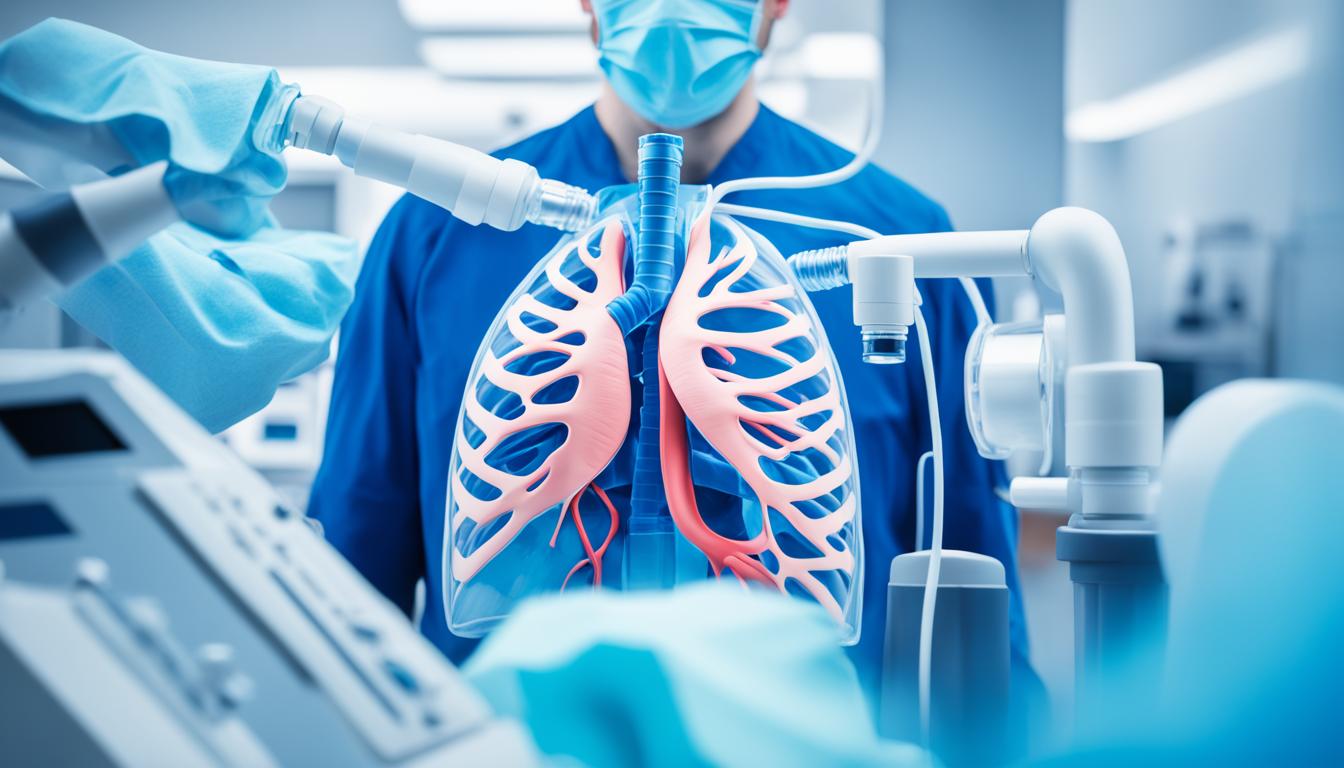Atelectasis is also called a collapsed lung. It happens when the small air sacs in the lungs don’t fully fill up with air. This leads to problems breathing, chest pain, and other issues. Atelectasis can be caused by things that block the airways. But, it can also happen from surgery, lung scars, and low surfactant.
The signs of atelectasis can change based on how much of the lung is affected. Doctors use X-rays, CT scans, and bronchoscopies to figure out if someone has it. The treatment can include therapy to help with breathing, surgery, or special breathing methods. Stem cell therapy is a new treatment for atelectasis that’s showing hope.
Key Takeaways:
- Atelectasis, or collapsed lung, is characterized by deflated or fluid-filled air sacs in the lungs.
- Obstructive atelectasis occurs when the airways are blocked, while nonobstructive atelectasis can be caused by various factors.
- Symptoms of atelectasis can range from mild to severe, including difficulty breathing and chest pain.
- Diagnosis of atelectasis involves tests such as X-ray, CT scan, and bronchoscopy.
- Treatment options for atelectasis depend on the underlying cause and may include chest physiotherapy, surgery, or breathing treatments.
- Stem cell therapy shows promise as an innovative treatment approach for atelectasis.
Causes of Atelectasis
Atelectasis means a collapsed lung. It can happen for different reasons. When the airways get blocked, air can’t reach the alveoli. This causes them to collapse. This blockage might be from breathing in foreign objects or having too much mucus in the airways.
Tumors or lung tissue putting pressure on the airways can cause blockage too. But, atelectasis can also happen without a blockage.
This kind might be due to surgery or having extra fluid in the chest cavity. It can also come from a collapsed lung caused by air or gas. Lung scarring or not having enough surfactant can lead to atelectasis too.
It’s important to know all the ways atelectasis can start. This helps doctors figure out the best way to treat it. By knowing what’s causing the issue, they can pick the right treatment.
Symptoms and Complications of Atelectasis
Atelectasis, also known as a collapsed lung, shows different symptoms depending on its severity. Some people with mild atelectasis might not have any symptoms. On the other hand, severe cases can cause difficulty breathing and other serious issues.
- Shortness of breath: Breathing may become harder, especially during activities or while lying down.
- Severe chest pain: Deep breaths or coughing can lead to sharp chest pain if you have atelectasis.
- Rapid breathing: Quick, shallow breaths might indicate atelectasis.
- Increased heart rate: A fast heartbeat might happen with breathing problems from atelectasis.
- Cyanosis: Severe atelectasis can cause a bluish color of the skin or nails, showing a lack of oxygen.
If not treated, atelectasis can lead to pneumonia in that area of the lung. This can cause a cough, fever, and chest pain. Infants and people with existing lung conditions face more serious risks from atelectasis. They may experience:
- Hypoxia: Lower oxygen levels from atelectasis can cause hypoxia, which needs quick medical care.
- Respiratory failure: Atelectasis, in severe instances, may lead to the inability to get enough oxygen, known as respiratory failure.
It’s crucial to recognize atelectasis’s signs and risks. This helps in getting the right diagnosis and treatment soon. Quick medical help can avoid further issues and improve the patient’s situation.
Diagnosis and Treatment of Atelectasis
Diagnosing atelectasis looks into the patient’s past health and uses different tests. These tests might be X-rays, CT scans, and bronchoscopies. They show the reason and how bad the atelectasis is. Also, checking the oxygen in the blood helps see the lung’s health.
The care for atelectasis changes based on what caused it and how bad it is. Simple cases might get better on their own. But, tougher cases need help. Doctors might give medicines to make throat mucus thinner. This helps clear the airways. Sometimes, surgery is needed to fix blockages in the airways.
Methods like chest physiotherapy, including deep breaths and changes in position, can reverse lung collapse. They make the lungs work better. New therapies, like using stem cells to treat atelectasis, look hopeful. Catching and treating atelectasis early is key. It helps control the problem and avoid complications.
FAQ
Q: What is atelectasis?
A: Atelectasis, also known as a collapsed lung, is when the small air sacs in the lungs don’t inflate fully. They may also fill with fluid. This can cause trouble breathing, chest pain, and more problems.
Q: What are the causes of atelectasis?
A: Atelectasis comes from both blocked and unblocked airways. Blockages cause obstructive atelectasis. Nonobstructive atelectasis might be from surgery, pleural effusion, or other issues.
Such issues can include lung scarring or a shortage of surfactant.
Q: What are the symptoms and complications of atelectasis?
A: Atelectasis symptoms can vary from mild to severe. They include trouble breathing, chest pain, and fast breathing. You might also notice a quickened heart rate and a blueish skin color, known as cyanosis.
In some cases, atelectasis leads to low blood oxygen and respiratory failure. This is more common in infants or those with existing lung conditions.
Q: How is atelectasis diagnosed and treated?
A: Doctors find atelectasis by checking your history and doing tests. These can include X-rays, CT scans, and bronchoscopies. They also check your blood’s oxygen levels.
The treatment varies based on what’s causing the atelectasis and how bad it is. Doctors might use medicine, surgery, or other methods like chest physiotherapy. Newer treatments, like stem cell therapy, are also being explored.

